No matter what your grass looks like right now, with a bit of TLC it can become your dream lawn. This article has lots of advice on how to get and maintain a beautiful lawn.
I tend to think of lawns a bit like people. Every patch of grass is unique. Each one has its plus points and its challenges and each one has the potential to be truly great.
Believe it or not, just like us, lawns have life-stages. There are the new ones just starting out, grown lawns struggling with their workload or their environment, and privileged grass swathes that are loved and cared for. I’ve “met” lawns from every category and in this blog, I’m going to share my secrets for caring for every type of lawn.
- Newly created lawns
- Lawns on new build properties
- Growing grass in shade
- Tired and worn out turf
- Mossy lawns
- Weedy lawns
- Damaged by pests or diseases
- Sparse grass
- Newly renovated lawns
- Lovely lawns that want to stay beautiful
This is quite a long article, so feel free to scroll down to the sections that most interest you.
Caring for new turf or grass seed
Just because your new lawn looks fantastic right now, it doesn’t mean it will stay that way. Would you indoor carpets stay beautiful if they weren’t cared for? I very much doubt it. Your outdoor carpet is much the same – except that it needs a different type of care.
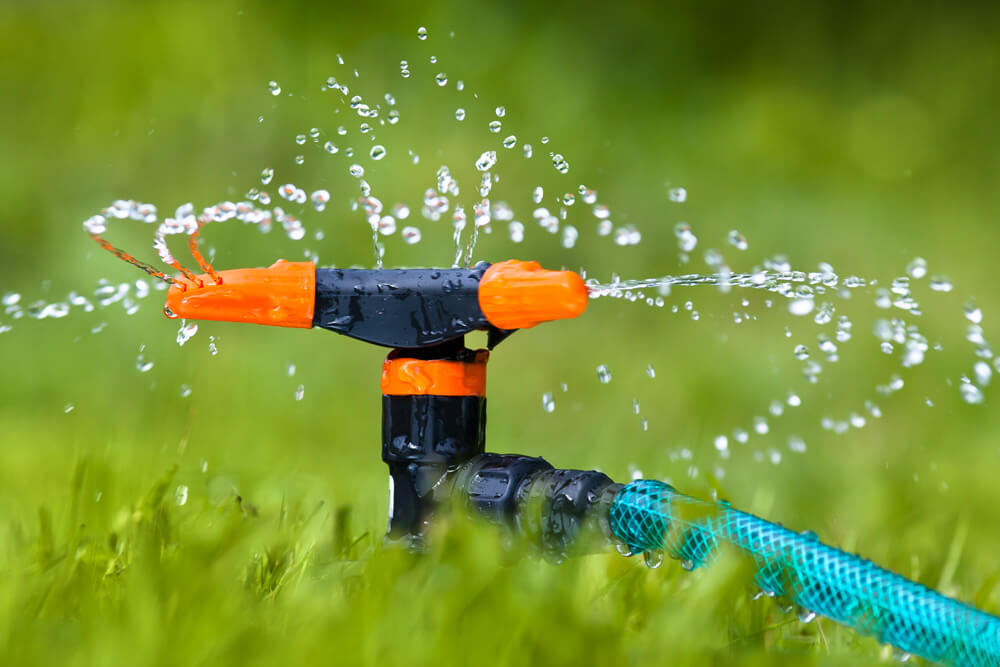
Watering new turf
Newly laid turf is especially vulnerable to drying out and must be watered every day until the roots are well established. How will you know the roots have settled into your soil? Tug on the leaves, if you feel the turf lift a little, it’s too soon to stop watering. If you rip out a handful of grass blades, it’s OK to gradually reduce the frequency and the amount of watering you do.
Mowing new lawns
Don’t be in too much of a hurry to mow your new lawn. Baby grass plants need to be at least 8 cm (3 inches) long before they receive their first haircut. New turf must be well rooted into the ground.
The number one rule for mowing any lawn is to make sure the mower blades are really sharp. Dull blades tear the grass and leave open wounds that let in diseases.
The second rule for mowing is to never remove more than one third of the vegetation. For a new lawn I’d be reluctant to take off more than ¼ of it’s length for the first three or four cuts.
So, set your super sharp mower blades nice and high, put the grass box on and just nip the tips off the grass blades.
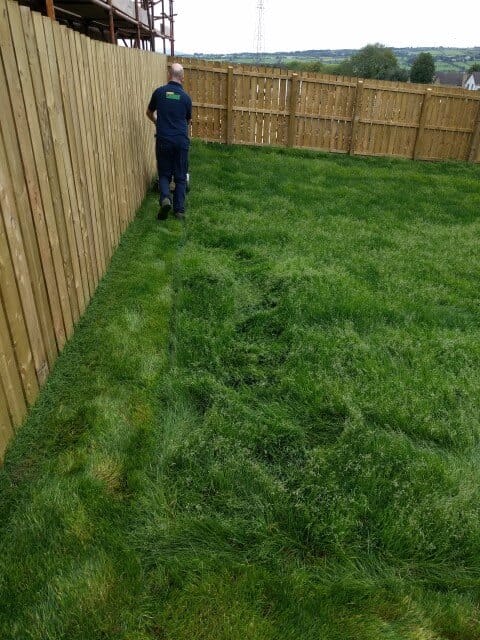
You can gradually reduce the length of the grass once the plants are really strong. Think of it like parenting a child – you wouldn’t ask a baby to do a full day’s work, but if you nurture him when he’s young, he’ll hopefully grow into a family breadwinner.
Mow little and often, gradually reducing the height of the cut as you go. For the first 6 months of a lawn’s life, try to avoid cutting lower than about 4cm (1.5 inches). 5-6 cm (2 inches) is an even better length for young grass.
Feeding new lawns
What you feed your new lawn is crucial to the way it develops. Notice I said “what” not “whether”. If you’re reading this blog I’m assuming that you really want your new lawn to succeed so there’s no question of you starving it.
When your lawn was laid or seeded, there should have been a pre-turfing fertiliser added to the soil before the grass was put down. That will provide enough nutrients for the first six weeks or so of your lawn’s life.

After 6 weeks, you can start a regular regime of feeding and lawn treatments keep your lawn happy and healthy for the whole of its life.
Read more about lawn treatments here
Lawns on newbuild properties
I’ve put lawns on newbuild properties into a category of their own, because they sometimes have some quite specific challenges.
If you’ve bought a new home with the turf already installed, you might notice a few anomalies in the lawn.
It will probably start out looking OK, but as time passes, there’ll be strange patches appear for no apparent reason. They may be baldy bits, or they may be a sickly yellow colour. You might also spot an influx of weeds or areas of lawn disease. The root cause of the problem usually lies in the soil.
Sometimes builders will save themselves time by spreading a shallow layer of topsoil over all the rubble in the garden and then laying turf on top of that. To be able to grow reasonably independently, grass needs at least 15cm depth of good quality topsoil to get its roots into.
Another potential problem in some gardens of newbuild homes is shade. Small spaces with tall fences can suffer with low light levels in parts of the garden – and grass does best in sunshine.
If your newbuild lawn is disappointing you have 3 options,
- Live with it (no thanks!)
- Dig it up and start again, removing rubble and using shade tolerant grass species if necessary
- Apply treatments more frequently than you otherwise would.
I’m more than happy to visit any problem lawn in the Belfast area to advise.
Growing grass in shade
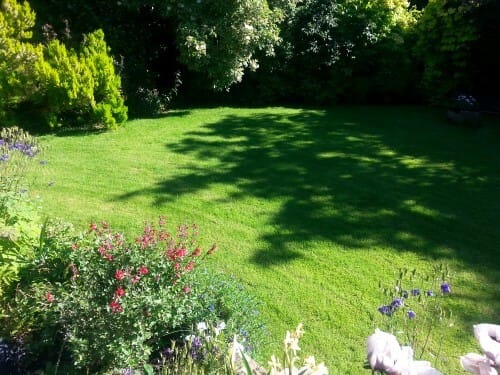
Grass needs three things to thrive
- Nutrient rich soil
- Water
- Sunlight
If the balance of the three is not quite right, then the grass will not necessarily fail, but it won’t create your dream lawn.
If you are struggling to grow a beautiful lawn because of shade, you can adjust your lawncare regime to help it along.
- Feed regularly with the right fertiliser for the season. What to feed your lawn and when.
- Lift your lawnmower blades so that you maintain the grass at around 10-15cm. That means the plants will have a bigger surface area to be able to make the most of what daylight they see.
- Overseed every autumn with a shade tolerant grass species.
- Keep moss under control
- If possible, trim hedges, trees and shrubs to let more light in.
If you’re having problems with a shaded lawn, please don’t give up, I can help. Call me to discuss your garden’s needs.
This is a case study featuring a shaded lawn in Glengormley – look how it recovered after a little TLC . Read the case study here
Worn out lawns
A worn out grass sward tells me it’s been well used and thoroughly enjoyed – which is exactly what lawns are for.
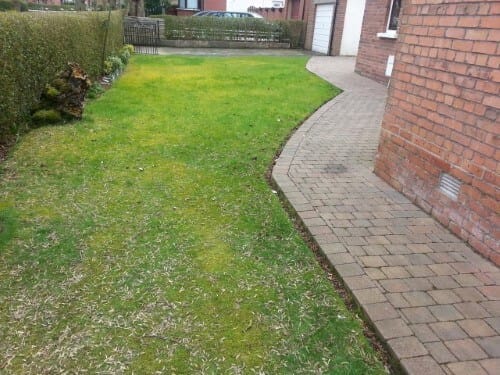
Typically, a tired lawn will have bare patches, thinning grass, a smattering of opportunist weeds and sometimes quite a pale colour. The root cause of the problem is usually a mix of two or three factors.
- Soil compaction – making it harder for the roots to find what they need in the soil
- Lack of nutrients – the plants don’t have the materials they need to heal themselves when they get damaged
- The wrong type of grass – some grass species are not suitable for heavy wear and tear.
The first stages in tackling a worn out lawn are scarification to clear away dead material and reveal what we’re dealing with. Followed by aeration to relieve the compaction.
Follow up with a nice treatment with lots of nutrients and a weedkiller if necessary. If the area is really bare, it can then be overseeded with an appropriate grass species.
It’s surprising how quickly a worn out lawn can recover.
More details in this blogpost from February 2018
Mossy Lawns
Moss is the scurge of gardeners everywhere. It’s an incredibly opportunistic plant whose needs are simple. For moss to reproduce all it needs is a damp shady spot. You will have seen moss growing on patios and walls – it doesn’t even need soil!
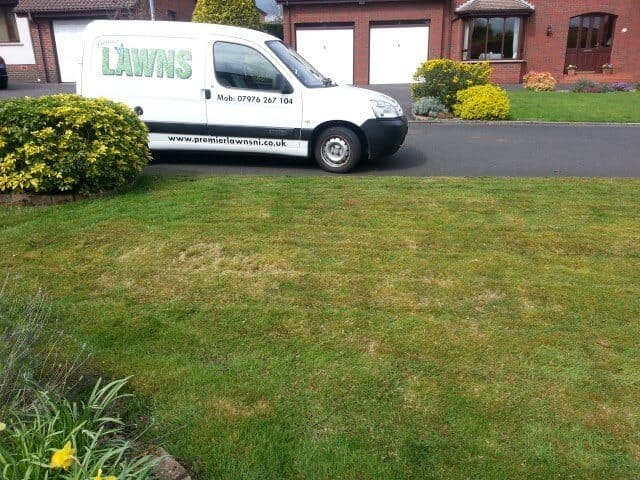
The trick to controlling moss is to
- Create conditions that moss doesn’t like and
- Make sure your lawn is strong enough to outcompete the plant
It’s not always easy to reduce shade, but trimming back any trees, shrubs and hedges adjacent to your lawn will definitely help.
In our climate, and especially with the clay soils around Belfast, dampness is unavoidable, but not uncontrollable. Compacted soil simply will not drain well, so regular aeration is one of the weapons in your moss control arsenal.
Soil aeration helps your grass to thrive, so aim to carry this out once or twice a year.
Scarification helps water to drain more freely away from your lawn. Scarifying removes moss too. It also clears away the thatch layer where moss spores lie dormant until they’re ready to grow.
Keep your lawn well fed and mow little and often. That way the plants are less likely to be stressed and they’ll be more able to outcompete the moss.
Having problems with moss? I can help you to treat it without you needing to hire machinery or muddle about with chemicals.
Contact Premier Lawns for help with moss control
Weedy lawns

If there’s one thing Mother Nature hates, it’s a monoculture. Yards and yards of the same species. And that’s exactly what a lawn is. So, whenever she gets the opportunity, Nature will try to bring different species into the mix. When they pop up in turf, we call those species “weeds”.
I’ve blogged about weeds in the past, so rather than repeat myself, here’s a link so that you can learn more about controlling weeds in lawns.
https://premierlawns.co.uk/weeds/
Lawns suffering with pests and diseases
Pests and diseases are all part of nature. Just as a healthy human can usually shake off a cold (unless it’s Man-Flu), a healthy lawn normally recovers quite quickly from a dose of fusarium patch disease or a light invasion of leatherjackets.

One garden invader that seems to worry my customers a lot, is the humble toadstool. They’re actually a sign of healthy soil and are rarely dangerous.
Find out why toadstools in your lawn are nothing to worry about

Of some lawn pests are our trusted family friends. Dog pee can do just as much damage as fungal disease. So managing a lawn when you have pets is all about compromise.
Here’s a blog I’ve written about lawns for dogs.
Sparse grass
It’s not unusual for me to encounter lawns that instead of being lush and velvety, look like the top of an elderly gentleman’s head. In other words, the soil is clearly visible through the thatch.
Sparse grass problems are usually easily solved with some renovation work.
That velvety texture on a lawn is a result of having a mixture of different grass species. Some have a beautiful green colour, others have fine leaves that form a dense sward.
Restoring that mix of species as well as correcting underlying problems with compaction or moss will soon thicken out a sparse sward.
Let me show you a garden in Cultra Holywood where the lawn was quite thin when we first visited. Over time we have reintroduced fine leaved grasses and helped them to thrive. As you can see in this case-study, the work has really paid off.
https://premierlawns.co.uk/lawn-renovation-cultra-holywood/
Newly renovated lawns
We’ve looked at all sorts of grass-related problems and the renovations that will help bring them back to beauty. Lawn renovation is a bit like surgery for a human – TLC is important during the recovery period.
I always encourage my lawn care customers to be gentle with their lawn for a couple of weeks after renovations. Especially if new seed has been sown.
This blog is full of advice on caring for newly renovated lawns
Lovely lawns that want to stay beautiful
A lawn is a living being and as such it’s in a constant state of change. It will react to the weather, to usage, to treatments, to pests and diseases and a whole host of different things. That’s why I think lawns are so interesting and so amazing.
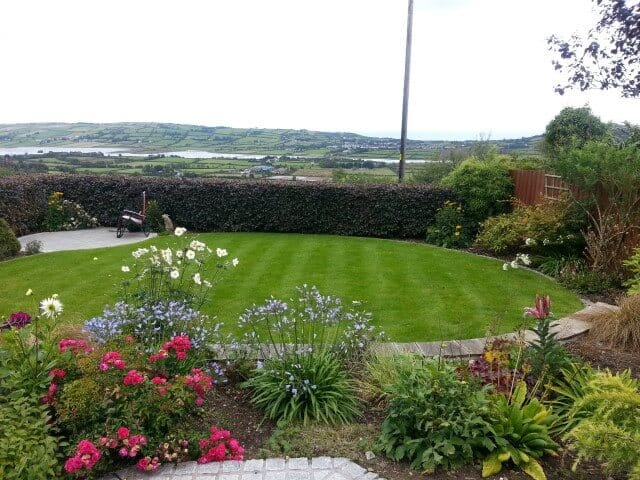
Once your lawn is looking just as you want it to, it will need maintaining. Mow little and often. Mow stripes into it if you want to. And plan in advance for bigger maintenance jobs.
Get out your diary and schedule in
- Regular feeds throughout the whole year. Every 4-6 weeks should do it.
- A seaweed supplement at least 3 times a year (early spring, late spring, mid-autumn)
- Scarification in autumn and spring – especially if your lawn is moss-prone
- Aeration at least once a year – more often for lawns with heavy footfall
Better still, ask a trusted lawncare professional for help. I work in and around Belfast and can help you to resolve lawn problems and tackle those bigger lawn care jobs such as mowing, feeding renovations, moss or weed control treatments and even hedge trimming to keep shade at bay.
Contact me today to find out just how cost-effective regular lawn care can be.
And don’t forget – if you’re lawn is playing up and you don’t know what to do, I’m here to help.
Contact Robbie with your lawncare queries
